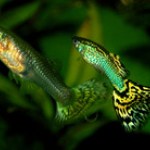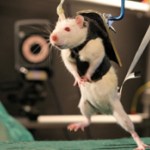brain
You may recall a prior post in which I talked about how intelligent crows are. In fact, there was a special on PBS demonstrating their ability to solve problems and even recognize human faces (HIGHLY recommended if you haven't yet had a chance to see it):
Watch A Murder of Crows on PBS. See more from Nature.
In a more recent study, Dr. Marzluff and colleagues used brain scans to demonstrate that crows not only remember faces, but they can also remember how they were treated by various people. In the study, his team captured 12 wild American crows while wearing latex "…
“If you want total security, go to prison. There you're fed, clothed, given medical care and so on. The only thing lacking... is freedom.” -Dwight Eisenhower
One of the greatest feelings is the freedom to travel, whether by your own power or a mechanical motor, far faster than your own legs can take you. Kimya Dawson understands how delightful this is (and how much is missing when you can't have it), as you can likely tell from her song,
My Bike
I've always loved the feeling of biking, fast, along a deserted road, feeling the wind rush past me and seeing the world go by.
Image credit: Flickr…
Studies of guppies show that bigger brains may mean "smarter" fish, but less offspring. Credit: Marrabbio2/Creative Commons
...at least for guppies. Dr. Alexander Kotrschal and colleagues at Uppsala University (Sweden) either shrank or grew the brains of guppies over multiple generations to create animals with up to 8-10% variations in brain size. To test for "smartness" they had the fish count by training the animals to look for food where a card with two or four symbols was shown. According to the researchers, the animals with larger brains tended to…
Scientists have been able to restore locomotion in paralyzed rats using a combination of nerve stimulation and engaging the mind by having the rats complete simple tasks (like obtaining treats). In the newly published research, Dr. Grégroire Courtine (University of Zurich and the Swiss Federal Institute of Technology) and his team created a rat model of spinal cord injury. After designing a support jacket for the rats, they used a combination of neurotransmitters and electrical impulses to excite the nerves to produce involuntary stepping actions, which alone did not activate…
Last May I heaved myself out of bed a little before 5am so I could undertake a mammoth 12 hour round trip to that pantheon of industrial decay, Rotherham. What did the home of Jive Bunny and the Chuckle Brothers have to entice me on such a journey? Why, only Science World 2011, Fisher Scientific's annual trade fair. And their keynote speaker for the day, the Baroness. No, not that Baroness. I'm talking about Professor Susan Greenfield, who has made something of a name for herself with her theories about the effects of the internet on the brain. Namely, that the pervasiveness of digital…
Nifty Fifty Speaker Carl Zimmer is often called one of the nation's most astute, informed and lyrical science writers. Specializing in communicating about the wonders and mysteries of evolution, biology and neuroscience, Carl Zimmer - in such books as The Tangled Bank, Parasite Rex, and Soul Made Flesh - writes with such grace, skill and clarity that he makes even difficult subjects like natural selection and the brain understandable and exciting to readers who have little formal education in science.
"I like to write books about subjects that greatly intrigue me --subjects that I want to…
NEW York City in the 1920s and '30s was a hotbed of criminal activity. Prohibition laws banning the production, sale and distribution of alcohol had been introduced, but instead of reducing crime, they had the opposite effect. Gangsters organized themselves and seized control of the alcohol distribution racket, smuggling first cheap rum from the Caribbean, then French champagne and English gin, into the country. Speakeasies sprang up in every neighbourhood, and numbered more than 100,000 by 1925. When prohibition was abolished in 1933, the gangsters took to other activities, such as drug…
Anne Dillard said "You can't test courage cautiously," but Institute scientists have found a way to test it fairly safely, at least.
One might think of courage as an abstract idea, but it turns out that acts of bravery reveal a unique activity pattern in the brain. An experiment at the Institute to identify the brain mechanisms that take control when the call to action conquers fear involved a live snake on a remote-controlled trolley and volunteers with a fear of snakes in an fMRI.
One of those really cool and useful "evolution stories" gets verified and illuminated by actual research. And blogging!
An oystercatcher is a wading bird of the family Haematopodidae, distributed in one genus, Haematopus. As is the case with many coast loving birds, there has been confusion about the limits of the 11 or so species known to exist worldwide. That itself is an interesting story (Hocke 1996), but one we will not go into now.
Adult coastal oystercatchers (some species are not coastal) eat all sorts of animals found in the intertidal zone, including shellfish of all sorts,…
WHO could have guessed that a protein isolated from pond scum would transform the way researchers investigate the brain? The protein, called channelrhodopsin (ChR), is found in algae and other microbes, and is related to the molecule in human photoreceptors that captures light particles. Both versions control the electrical currents that constantly flow in and out of cells; one regulates the algae's movements in response to light, the other generates the nervous impulses sent along the optic nerve to the brain. Unlike its human equivalent, the algal ChR controls the currents directly because…
FOR most of us, the ability to navigate our environment is largely dependent on the sense of vision. We use visual information to note the location of landmarks, and to identify and negotiate obstacles. These visual cues also enable us to keep track of our movements, by monitoring how our position changes relative to landmarks and, when possible, our starting point and final destination. All of this information is combined to generate a cognitive map of the surroundings, on which successful navigation of that environment later on depends.
Despite the importance of vision for navigation,…
The fine folks at NPR's RadioLab have produced a new episode based on Strangers in the Mirror, which features Oliver Sacks and Chuck Close (and was moderated by RadioLab's own Robert Krulwich).
Have a listen over at their site. Or add to your cue wherever podcasts are sold for free (ie, iTunes). And check out their amazing back catalogue of archived shows while you're there.
I've been asked by several people about the famous people recognition demonstration used in this program. To take the actual test developed by go-to prosopagnosia experts, Brad Duchaine and Ken Nakayama, that I based the…
If you can't make it to the Tishman Auditorium in New York tonight to catch the highly anticipated program The Limits of Understanding, we've got you covered. The event will be streaming live, but we'll also be there to cover it, so follow along with the commentary alongside the video stream, and feel free to join in! The event starts at 8:00 EST. Moderator Sir Paul Nurse, a Nobel Laureate and President of Rockefeller University, will join mathematician Gregory Chaitin, philosopher Rebecca Newberger Goldstein, astrophysicist Mario Livio, and A.I. pioneer Marvin Minsky in a discussion about…
Image courtesy of the Cajal’s Butterflies of the Soul gallery at The Beautiful Brain.
Noah Hutton is founding editor of The Beautiful Brain, an online magazine that explores recent neuroscience findings through monthly podcasts, essays, reviews, and galleries, with particular attention to the dialogue between the arts and sciences.
Some of our greatest triumphs as a species have come from those who saw little difference between being a scientist and being a humanist. From Leonardo’s visionary notebooks to Herschel’s lunar poetry, science has provided a necessary resource for some great art;…
Sam McDougle joins us from re:COGNITION at The Beautiful Brain. Sam splits this time between behavioral neuroscience research at the University of Pennsylvania, playing fiddle in an Appalachian string-band, and drumming in an indie rock trio.
In my recent career as an undergraduate, I noticed a curious phenomenon–around my junior year, dorm rooms across the campus were suddenly spending Friday nights captivated by the wonders of the natural world, led along by David Attenborough’s poised intonations. BBC’s Planet Earth box set would soon be as ubiquitous in 18-24 year olds’ DVD collections…
DAYDREAMING is a critical component of conscious experience. The mind can perform mental time travel - it occasionally strays from the present moment, to recollect an experience from the near or distant past, or to imagine an event that has not yet taken place. We know that thinking about the future is dependant on memory, because patients with amnesia cannot imagine new experiences. It involves piecing together fragments of past experiences to generate a plausible simulation of what might happen. This may have been an important development in human evolution, as it enables us anticipate a…
OF all the techniques used by neuroscientists, none has captured the imagination of the general public more than functional magnetic resonance imaging (fMRI). The technique, which is also referred to as functional neuroimaging and, more commonly, "brain scanning", enables us to peer into the human brain non-invasively, to observe its workings and correlate specific thought processes or stimuli to activity in particular regions. fMRI data affect the way in which people perceive scientific results: colourful images of the brain have persuasive power, making the accompanying data seem more…
Chuck Close, Self-Portrait. Photograph: Ellen Page Wilson/Courtesy PaceWildenstein, New York
Imagine a chair. It has physical attributes: four legs, a seat, some sort of a back. Now imagine a human face. It also has physical attributes: eyes, a nose, a mouth. But, remarkably, the ways we process these features in our brains—and more crucially how we remember them—are significantly different, relying on wholly distinct neural pathways. Social memory it turns out is a completely different cognitive task than, say, remembering everyday inanimate objects, numbers and dates, or events. Nowhere is…
GAMBLING is extremely popular, with lottery tickets, casinos, slot machines, bingo halls and other forms of the activity generating revenues of more than £80 billion each year in the UK alone. For most people, gambling is nothing more than an entertaining way to pass the time. But for some, it becomes a compulsive and pathological habit - they spend increasing amounts of time gambling, because tolerance builds up quickly, and experience withdrawal symptoms when they aren't gambling.
The terms "tolerance" and "withdrawal" are normally associated with drug addiction, and indeed pathological…


